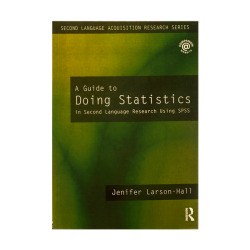A Guide to Doing Statistics Writer: Jenifer Larson–Hall
Chapter 2: Some Preliminaries to Understanding Statistics
Saeed Mojarradi: Follow – Instagram: saeedmojarradi
——————————————————————————————-
Inferential statistics
Statistics which can be generalized to a population wider than your sample are called inferential statistics.
Variables
What’s your research question?
What are your variables?
We need to know what kinds of measurements will be done.
Then we need to think about how we can operationalize the research question?
For example in this research question:
Would playing an online role-playing game in another language help students learn in Spanish better?
How will we measure this is Spanish?
Are we interested in there is speaking ability come out there listening ability, their reading ability or all of these?
Say we are interested in there speaking ability.
Then how will we measure it?
Will we give them standardized Spanish oral proficiency interview test (OPI)?
Will we just have an informal interview?
Will we use grades from the last Spanish class?
All of these are ways to operationalize the variable over speaking proficiency in Spanish.
Think about what needs to be measured in order to operationalize the research question?
How will we measure the Spanish proficiency?
What group will participants be in?
Answer: we will need at least two groups in order to show that it’s the game playing that help participants improve?
Level of measurement of variables
Answering this question and does operationalizing your research question were resolved in measurement variables.
Measuring a Spanish speaking proficiency will probably be done through some kind of test their participants will receive a variety of escorts. That’s called continuous variable.
The values of a continuous variable consist of numbers that represent in measurement and involved a large range of possible answers.
A continuous variable contrasts with a categorical variables where the values of the variable basically do not have any inherent numerical value and consist of categories where one category is not rated any higher than any other.
The skill of identifying whether your variables are continuous or categorical is absolutely essential of deciding what is statistical test to use, and in general the division between continuous and categorical is the most important division to know when it comes to performing a statistical tests, some tests can be used only when all variables are continuous while other tests can be used only when there is at least one categorical and one continuous variable.
Three levels of measurement:
Nominal
Ordinal
Interval
Nominal Scales: which measure categorical variable do not have any inherent numerical value. They are used to group people or data and include measurements like gender, group membership in an experiment. First or second language background who presents absence of a linguistic feature.
Ordinal scale are rank ordered and do have some inherent numerical value. For example, we might have first second and third year students of French. If we assigned the students in number based on their number of years of study we would expect this to be reflected in their knowledge of French with students with the higher number having more knowledge of French we might not expect however that the difference between third year students and second year students who would be the same as between second year and first year students. In other words, there is no guarantee that there are equal in terms of measurement between the participants.
In an interval Scale which measures continuous variable however we would like to say that the difference between getting a 9 and a 10 on a 10 point test is the same as the difference between getting a 3 and a 4 on a test. In other words, the intervals are assumed to be equal authors will also distinguish a ratio scale which has all the properties of an interval scale plus the scale has a true zero point.
Why do you need to know about nominal, ordinal, and interval scales?
The Division between categorical and continuous variable which is the same as the division between nominal and interval scales is in practice. The Division which is important in deciding which statistical test to choose.
Researchers who use a measurement which is ordinal end of classifying it as either categorical or continuous often depending on how many points there are in the scale.
For example, if you have recorded the years of study of college learners of French and you have three levels you will most likely call this a categorical variable with no in here and numerical value even though you don’t realize that most learners in their first year of friendship study will perform better than learner’s in the first year.
In truth it is not the measurement itself but how the researcher chooses to look at it that is the deciding factor in whether you will call a measSet featured imageurement continuous or categorical.
Application activity practice in identifying levels of measurement
Does accuracy in guessing the meaning of unfamiliar to Japanese words differ depending on proficiency level?
Proficiency level divided participants into high and low proficiency on the basis of Reading comprehension tests with maximum possible score of 20 points.
Dependent and independent variables
Another important dichotomy between variables is whether they are considered independent or dependent.
Both independent and dependent variables can be measured as nominal ordinal or interval so this division is independent of the measurement scale.
This dichotomy relates to the way the variables function in the experiment.
Independent variables are those that we think may have an effect on the dependent variable.
Often the researcher controls these variables.
For example, an independent variable would be membership in one of three experimental conditions for learning vocabulary mnemonic memorization, rote memorization, and exposure to context laden sentences.
Independent variables are not always variables that the researcher manipulate however. if you think that amount of motivation and presence at a weekly French conversation chat group influence fluency in French, you will simply try to measure motivation and chat group attendance.
Here are some common independent variables in second language research studies:
– Experimental group membership
– Language one background
– Proficiency level
– Age
– is statues as monolingual or bilingual
The variable that you are interested in seeing effected is the dependent variable. For our French examples the dependent variable is a fluency in French measure.
If the Independent variables have been fixed, then the dependent variable is beyond the experimenters controlled. For example, the researcher may fix which experimental group the participant belong to and then measure their scores after the treatment on a vocabulary test.
Here are some common dependent variables in second language research studies:
- fluency ratings
- Score discrete point tests
- number of accurate grammatical forms out of all instances of that grammatical form used
Actually the difference between independent and dependent variables is not always clear cut and in some cases this traditional dichotomy may not really be applicable.




